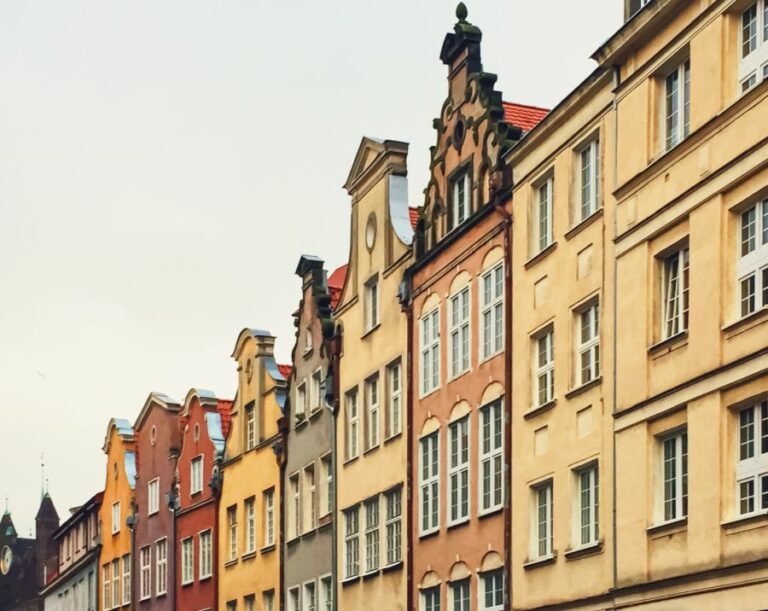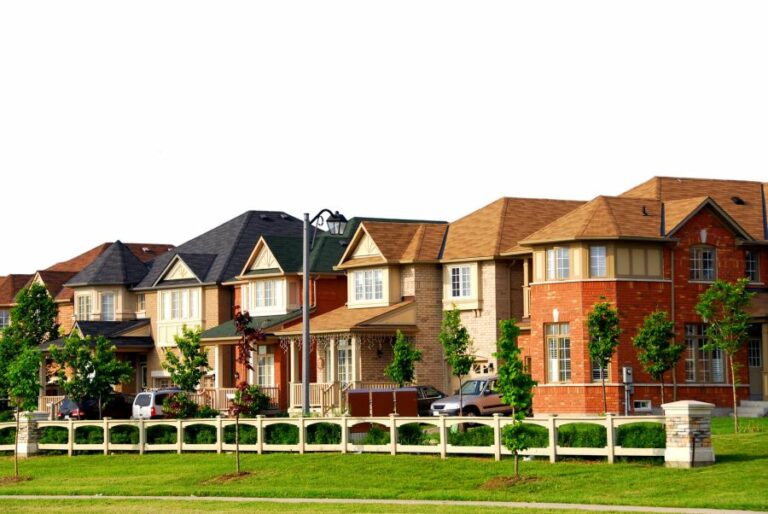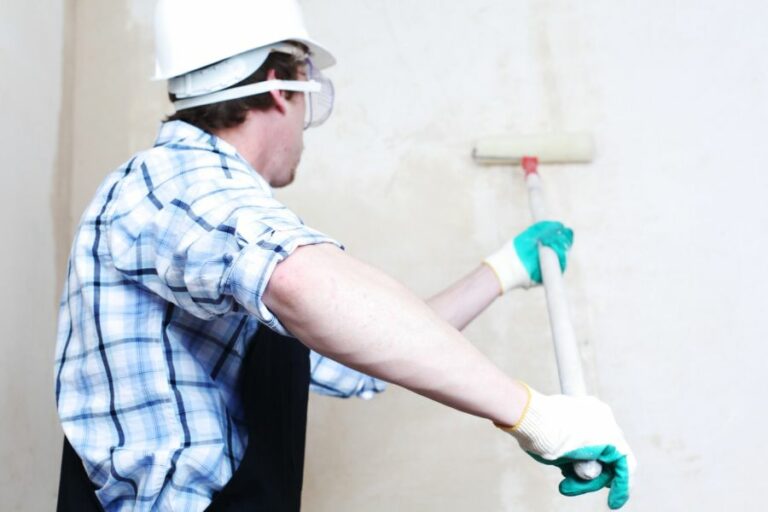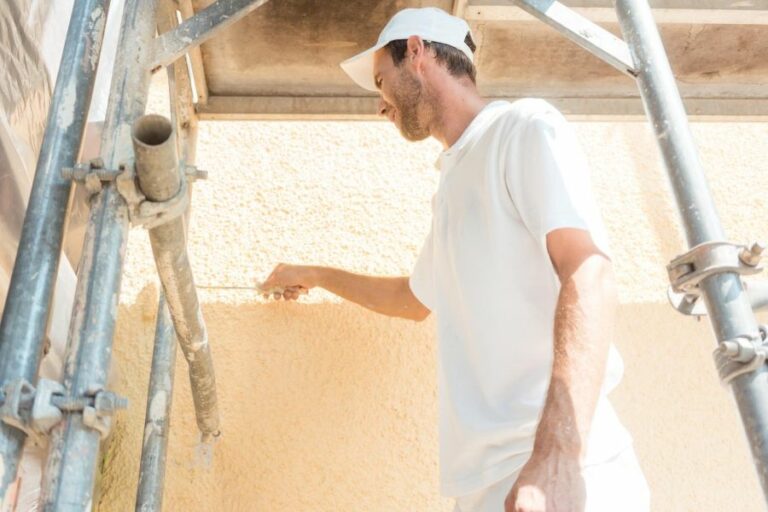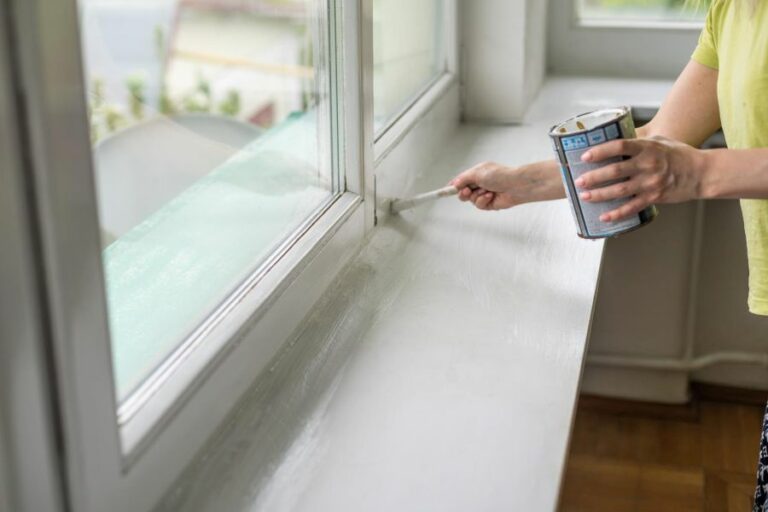High-Pressure Exterior Cleaning Process. What Pros Say
Are you tired of dealing with stubborn dirt, grime, and algae on your property’s exterior? Fear not; we have the perfect solution to transform and rejuvenate the exterior surfaces with remarkable results. Introducing the high-pressure exterior cleaning process, a highly effective and efficient method designed to tackle even the most challenging tasks.
High-pressure exterior cleaning process:
High-pressure exterior cleaning, also known as pressure washing or power washing, is an efficient and eco-friendly method that uses high-pressure water spray to remove dirt, grime, mold, and other contaminants from surfaces like walls, sidewalks, driveways, and roofs. It provides a cost-effective and time-saving alternative to traditional cleaning methods while improving the appearance and safety of properties.

Dive into the world of high-pressure exterior cleaning and discover the powerful techniques used to remove the toughest dirt, grime, and stains from your home’s surfaces.
Read on to learn how these methods deliver stunning results, extending the life of your property while maintaining its aesthetic appeal. Don’t miss out on these transformative solutions!
Contents
- 1 Intensive Outdoor Cleaning with High-Pressure Techniques
- 2 Mastering the Art of High-Pressure Cleaning
- 3 Step-by-Step Guide to Pressure Washing Your Home
- 4 Effective Power Washing Techniques for Exteriors
- 5 Pre-Treatment Solutions for Pressure Washing Concrete
Intensive Outdoor Cleaning with High-Pressure Techniques
• What Is High-Pressure Exterior Cleaning?
High-pressure exterior cleaning, also known as pressure washing or power washing, is a process that utilizes high-pressure water spray to remove dirt, grime, mold, and other contaminants from surfaces like walls, sidewalks, driveways, and roofs.
This cleaning method provides an efficient and effective way of improving the appearance of your home or commercial building without causing any damage to the surface.
• Benefits Of High-Pressure Exterior Cleaning
– Time-efficient Cleaning
High-pressure exterior cleaning significantly reduces the time required to clean large surfaces. The powerful water spray can quickly remove even the toughest dirt and grime, allowing you to complete your cleaning tasks much faster than traditional methods.
– Environmentally Friendly
Pressure washing requires only water and, if necessary, a minimal amount of eco-friendly cleaning agents. This means that harmful chemicals are not released into the environment during the process, making it an environmentally friendly option for exterior cleaning.
– Cost-effective Method
High-pressure exterior cleaning is a cost-effective alternative to repainting or replacing surfaces. It restores surfaces to their original appearance by eliminating accumulated dirt, stains, and mildew, making it an excellent choice for maintaining the exterior of your property.
– Safety and Health Benefits
By removing mold, mildew, and algae, high-pressure exterior cleaning can improve the safety of exterior surfaces, such as pathways and driveways, by reducing the risk of slipping on these contaminants. Additionally, it can enhance the overall health of your property by eliminating potential allergens.
• Essential Equipment For High-Pressure Exterior Cleaning
– Pressure Washer
The most important piece of equipment needed for high-pressure exterior cleaning is a pressure washer. These machines are available in various types and sizes, ranging from small electric-powered units to larger gas-powered models.
When selecting a pressure washer, consider factors such as the size of the area you need to clean and the type of surfaces you will be working on.
– Nozzles and Attachments
Pressure washers come with a variety of nozzles and attachments that allow you to customize the water spray for different cleaning tasks.
For instance, fan nozzles produce a flat, wide spray pattern suitable for cleaning large areas, while rotating nozzles create a concentrated, circular spray pattern for removing stubborn dirt.
– Cleaning Solutions
While most high-pressure exterior cleaning can be completed using only water, you may require cleaning agents for particularly stubborn dirt or stains. Always select eco-friendly, biodegradable cleaning solutions to avoid harming the environment.
– Protective Gear
Proper protective gear, including goggles, gloves, and non-slip shoes, is essential when using a pressure washer to ensure your safety during the cleaning process.
• Best Practices For High-Pressure Exterior Cleaning
– Test on a Small Area First
Before starting the cleaning process, it’s advisable to test your pressure washer and cleaning solution in a small, inconspicuous area. This allows you to confirm that the pressure and solution are appropriate for the surface without causing any damage.
– Maintain a Safe Distance
During high-pressure exterior cleaning, always maintain a safe distance between the nozzle and the surface being cleaned. Holding the nozzle too close to the surface can cause damage, while holding it too far away may result in an ineffective cleaning process.
– Use Appropriate Pressure
Select the appropriate pressure settings for the surface you are cleaning. Lower pressure settings are suitable for delicate surfaces such as wood, while higher pressure settings are required for sturdier surfaces like brick or concrete.
– Clean in a Consistent Pattern
To achieve the best results, clean in a consistent pattern, moving the nozzle in smooth, overlapping strokes. This ensures even cleaning and reduces the risk of leaving streaks or unevenly cleaned areas.
– Rinse Thoroughly
After completing the cleaning process, rinse the surface thoroughly to remove any remaining dirt or cleaning solution. This helps to prevent residue build-up and maintains the appearance of your freshly cleaned surface.
• Conclusion
High-pressure exterior cleaning is an efficient, effective, and environmentally friendly method for maintaining the appearance and safety of your property.
With the right equipment, cleaning solutions, and best practices, you can achieve professional-quality results in a fraction of the time required by traditional cleaning methods.
Mastering the Art of High-Pressure Cleaning
High-pressure cleaning, also known as pressure washing, involves the use of a powerful stream of water to remove dirt, grime, and stains from various surfaces.
This cleaning method is effective for both residential and commercial properties and can be used on a wide range of surfaces, including concrete, brick, wood, and more.
• Safety Precautions for High-Pressure Cleaning
Before getting started, it is essential to be aware of and follow necessary safety precautions to prevent accidents or damage during the cleaning process. Here are some key safety tips to keep in mind:
- Wear Protective Gear: Eye protection, gloves, and waterproof clothing are crucial when working with high-pressure equipment.
- Avoid Direct Spray: Never point the high-pressure nozzle at yourself or others, as it can cause injury.
- Secure the Area: Ensure that the area you are working in is clear and free of other people or animals.
- Follow the Equipment Manual: Always read and follow the manufacturer’s instructions for your specific pressure washer model.
• Choosing the Right Pressure Washer
When it comes to selecting a pressure washer, there are two main types to choose from: electric and gas-powered models. Electric pressure washers are ideal for light-duty tasks, while gas-powered variants offer more power for heavy-duty cleaning jobs.
After determining the type of pressure washer you need, consider the following specifications:
- Pressure: Measured in pounds per square inch (PSI), higher PSI means more cleaning power.
- Water Flow: Gallons per minute (GPM) measures the water flow, with a higher GPM resulting in faster cleaning.
- Nozzle Types: Most pressure washers come with a variety of nozzle sizes for different cleaning tasks.
Remember, higher PSI and GPM values may result in faster cleaning, but they also increase the chance of surface damage. Therefore, it is important to select a pressure washer with the appropriate specifications for the job.
• Preparing the Area and the Pressure Washer
Before you start cleaning, it is essential to prepare the area and set up the pressure washer correctly. Here are a few steps to follow:
- Clear the Area: Remove all items, such as furniture, toys, and tools, from the area you plan to clean.
- Cover Delicate Items: Protect delicate items or plants with tarps or plastic sheeting.
- Check the Surface: Inspect the surface for any cracks or damage that may worsen during the cleaning process.
- Connect the Pressure Washer: Attach the hose, wand, and nozzle to the pressure washer according to the manufacturer’s instructions.
- Prepare the Cleaning Solution: If you plan to use a detergent, create the cleaning solution as per the manufacturer’s guidelines and fill the detergent tank.
• Conducting the High-Pressure Cleaning Process
Now that the area and equipment are prepared, follow these steps for effective high-pressure cleaning:
- Test the Pressure: Before starting the job, test the pressure on a small hidden area to reduce the risk of damaging the surface.
- Start at a Distance: Begin cleaning from a distance of about 3 feet from the surface, gradually moving closer if needed.
- Use an Appropriate Nozzle: Select a nozzle that is suitable for the task and surface material.
- Apply Detergent: Apply the cleaning solution at low pressure using a nozzle with a wider spray angle.
- Allow the Detergent to Soak: Wait for 5-10 minutes, allowing the detergent to act on the dirt and grime.
- Avoid Drying: Make sure the detergent does not dry on the surface during the soaking period.
- Rinse Thoroughly: Remove the detergent and dirt by washing from top to bottom, ensuring a thorough and even rinse.
Remember to maintain a consistent distance and angle when spraying to prevent streaks or uneven cleaning.
• Additional Tips for Effective High-Pressure Cleaning
Here are some additional recommendations to enhance your high-pressure cleaning experience:
- Use Additional Attachments: Consider using specialized attachments such as a surface cleaner for large, flat areas or a rotating brush for scrubbing stubborn stains.
- Start with Low Pressure: Always start with the lowest pressure and increase as needed to avoid damage to the surface.
- Clean in a Consistent Pattern: Maintaining a consistent cleaning pattern, such as sweeping from left to right, helps ensure thorough and even coverage.
- Schedule Regular Maintenance: Plan periodic high-pressure cleaning to keep your surfaces looking fresh and clean.
- Seek Professional Assistance: If you are unsure about tackling a high-pressure cleaning job, don’t hesitate to consult a professional for advice or assistance.
• Conclusion
High-pressure cleaning is an effective technique for removing dirt, grime, and stains from various surfaces.
By following the guidelines and tips provided in this article, you can safely and effectively conduct high-pressure cleaning tasks on your residential or commercial property. As always, consult a professional if you are unsure about any aspect of the high-pressure cleaning process.
Step-by-Step Guide to Pressure Washing Your Home
Pressure washing your house is an important aspect of home maintenance, helping to remove dirt, algae, and mold to improve the overall appearance and prolong the life of your home’s exterior surface.
• Choosing the Right Equipment for Pressure Washing
Before you begin, it’s essential to select the appropriate equipment for the task. Pressure washers come in various types and capacities, and it’s essential to choose one that suits your requirements. A milder pressure washer (1,500 to 2,000 PSI) is generally suitable for most home exterior surfaces, while higher PSI units can cause damage to certain materials.
Personal Recommendation: Electric pressure washers offer more effortless maneuverability and are well-suited for most residential applications. Should you need more power, consider a gas-powered pressure washer.
Additionally, you’ll need specialized attachments and safety gear for the task:
- A pressure washer nozzle (usually color-coded) with a wide-angle spray
- A detergent and suitable injector system for your pressure washer
- Extension wand or telescoping wand for multi-story homes
- Waterproof work gloves, safety goggles, and non-slip footwear
• Preparing the Surface and Area for Pressure Washing
Before you start pressure washing, take the necessary precautions to protect your property and avoid injury:
- Turn off the electricity to any outdoor outlets, light fixtures, or other vulnerable electrical components.
- Close all windows and doors tightly to prevent water and detergent infiltration.
- Remove or cover delicate items such as plants and outdoor furniture from the area.
- Inspect the exterior surface for any loose or damaged materials that may require repair before pressure washing.
• Applying Detergent to the House
Using a detergent specifically formulated for pressure washing is crucial since it helps to loosen dirt, algae, and mildew for more effective cleaning.
- Fill the detergent reservoir with the appropriate cleaning solution, ensuring to follow the manufacturer’s instructions for dilution.
- Attach the wide-angle nozzle (typically the white or black one) to your pressure washer.
- Starting at the bottom of your house and working your way up, apply the detergent using a slow and consistent side-to-side sweeping motion. Make sure to overlap each pass slightly to prevent streaking.
- Allow the detergent to sit on the surface for a few minutes without letting it dry.
Note: Avoid applying detergent to windows as it may leave streaks or even cause damage.
• Rinsing and Pressure Washing the House
Now that the detergent has had a chance to loosen the dirt and grime, it’s time to rinse and pressure wash your home:
- Remove the detergent injector system from your pressure washer and attach the high-pressure nozzle (usually the green or yellow one).
- Starting at the top of the house, work your way down with a steady, overlapping sweeping motion, keeping a consistent distance from the surface (approximately 18-24 inches).
- Avoid holding the spray too close or for too long on a single spot, as this may cause damage to the siding or paint.
- When cleaning areas with mold or algae, consider rinsing multiple times to ensure thorough removal.
- Clean hard-to-reach areas like gutters, eaves, and second-story siding using an extension or telescoping wand.
• After the Pressure Washing: Inspection, Cleaning, and Drying
Once the pressure washing is complete, it’s essential to inspect your home to ensure a thorough and even cleaning. Look for areas that may require additional cleaning, and carefully inspect the windows, doors, and other vulnerable areas for any water infiltration.
Lastly, allow your house to air dry for 24-48 hours before attempting any touch-up paint jobs or other maintenance tasks.
• Conclusion
With the right equipment, preparation, and technique, pressure washing your house can be a straightforward and rewarding experience.
By following this step-by-step guide, you’ll be able to revitalize your home’s exterior safely and effectively, prolonging its lifespan and improving its overall appearance.
Effective Power Washing Techniques for Exteriors
Power washing is an effective way to clean and maintain the exterior of your home, giving it a fresh and appealing look.
• Choosing the Right Equipment
To begin, selecting proper equipment is essential for successful power washing. There are two main types of pressure washers: electric and gas-powered. I recommend using an electric pressure washer for most residential jobs, as they are more environmentally friendly and quieter.
Gas-powered washers are suitable for larger areas or commercial jobs, as they are more powerful.
As for pressure ratings, a minimum of 2000 PSI (pounds per square inch) is recommended for residential use. If you are unsure which pressure washer to choose, consult your local hardware store or Consumer Reports for guidance.
– Useful Accessories
There are multiple accessories available that can make power washing more efficient and easier. One such accessory is the surface cleaner attachment, which can be mounted on the pressure washer’s wand to clean flat surfaces more quickly.
Another helpful tool is an extension wand, which allows you to reach higher areas without needing a ladder.
• Preparing the Area
Before you start power washing, it’s essential to prepare the area around your home. Clear away any furniture, decorations, or vehicles to create space for your work.
Don’t forget to cover any electrical outlets with waterproof tape or plastic bags to prevent water from entering and causing damage.
– Protect Your Plants
When using a power washer, it’s important to protect your plants, as the high-pressure spray can damage their foliage. Cover the plants with a plastic sheet or tarp, and if possible, wet the plants before power washing to prevent any cleaning solution from absorbing into the leaves.
• Cleaning Solutions
Although water alone can remove dirt and grime, using a cleaning solution specifically designed for power washers will provide better results. These solutions can be purchased at your local home improvement store or online.
Remember to follow the manufacturer’s instructions when mixing the cleaning solution with water.
– Environmentally Friendly Options
If you prefer using a more eco-friendly cleaning solution, there are products available that are biodegradable and non-toxic to plants and animals. Look for products labeled as “green” or “environmentally friendly” when purchasing your cleaning solution.
• The Power Washing Process
Now that you have the proper equipment and you’ve prepared the area, it’s time to start power washing.
– Ideal Weather
First, choose a day with low wind and no rain in the forecast. This will not only make the process easier but also reduce the chance of debris flying around and water spots forming on your home’s surfaces.
– Be Conscious of Your Safety
When using a power washer, wear protective eyewear, gloves, and closed-toe shoes. Additionally, be aware of the high-pressure spray and avoid pointing it at yourself or others.
– Working Technique
Start at the top of your house and work your way down, ensuring that you are constantly moving the pressure washer to avoid damaging the surface.
Hold the nozzle at a 45-degree angle, and maintain a safe distance of 6 to 24 inches from the surface. This will depend on the pressure of your washer and the surface being cleaned.
– Cleaning Specific Surfaces
Different surfaces in your home may require unique cleaning techniques or methods. For example, when cleaning vinyl siding, use a soap nozzle to apply the cleaning solution and follow the pattern of the siding.
To clean wood surfaces, use a gentle pressure setting and move the nozzle in long, smooth strokes.
• After Care and Maintenance
Once you have completed power washing your home’s exterior, make sure to carefully remove and store all equipment. Disconnect any hoses, turn off the pressure washer, and empty any remaining cleaning solution.
– Regular Maintenance
Power washing should ideally be performed once a year to maintain your home’s cleanliness and curb appeal. After power washing, inspect the exterior for any necessary repairs or maintenance, such as repainting or caulking around windows and doors.
In conclusion, power washing your home’s exterior can transform its appearance and maintain its long-term value. By following the steps and recommendations provided in this guide, you will be well-prepared to power wash your home like a pro.
Steps | Description |
|---|---|
1. Choose the appropriate equipment | Select a suitable power washer with the appropriate pressure and nozzle attachment to clean your exterior without causing damage. |
2. Protect plants and windows | Cover plants with plastic sheeting and keep windows closed to prevent water from entering your home. |
3. Apply detergent if necessary | For stubborn dirt or stains, use a cleaning solution compatible with your power washer and apply from the bottom up to avoid streaks. |
4. Start power washing | Begin power washing from the top down, applying even pressure while maintaining a safe distance from the surface. |
5. Rinse thoroughly | After the detergent has done its job, switch to a lower-pressure nozzle and rinse the exterior thoroughly from top to bottom. |
6. Allow the surface to dry | Let the exterior air dry before removing any protective sheeting or reapplying sealant or paint. |
Pre-Treatment Solutions for Pressure Washing Concrete
When it comes to pressure washing your concrete surfaces, whether it is your driveway, patio, or sidewalk, it is essential to use the right solutions and techniques to get the best results.
• Importance of Pre-Treatment Solutions for Concrete
Using a pre-treatment solution before pressure washing your concrete surface is vital because it helps remove stubborn stains, grime, and dirt.
These solutions assist in breaking down the pollutants and loosening them from the concrete surface, making it easier for the pressure washer to clean the area without causing any damage.
Additionally, using an appropriate solution can save water, work, and time as it enhances cleaning efficiency.
• The Stain Type: Identifying Your Cleaning Needs
Before selecting the best pre-treatment solution, it’s essential to identify the type of stain you are dealing with.
Concrete can accumulate various stains like oil, grease, algae, moss, mildew, and dirt. Below are some different types of pre-treatment solutions that work best on specific types of stains:
– Alkaline Cleaners
Alkaline cleaners are ideal for removing oil, grease, and other organic stains from concrete. They work by raising the pH level of the concrete, breaking down stains, and loosening them from the surface.
– Acid-Based Cleaners
Acid-based cleaners work best on stains caused by rust, efflorescence, and hard mineral deposits. They function by lowering the pH level of the concrete and reacting with the stain, dissolving it, and separating it from the surface.
– Biological Cleaners
Biological cleaners contain non-toxic enzymes and microorganisms that break down organic stains like algae, moss, and mildew. These cleaners are environmentally friendly and work efficiently on porous concrete surfaces.
– Bleach-Based Cleaners
For removing mold, mildew, and algae stains, bleach-based cleaners are effective. However, it is crucial to use them with caution as they can damage the concrete surface if not mixed correctly with water or applied carefully.
– Degreasers
Degreasers are heavy-duty cleaners that remove oil, grease, and other petroleum-based stains from concrete surfaces. They work by breaking down and dissolving these substances, making it easier to wash them away.
• Recommended Commercial Solutions
There are many pre-treatment solutions available in the market that cater to different types of stains on concrete surfaces. Here are a few popular commercial products:
- Simple Green Oxy Solve Concrete and Driveway Cleaner: This cleaner is an oxygen bleach-based formula that effectively removes grease, grime, and mildew stains. It is also biodegradable and phosphate-free.
- Krud Kutter Concrete and Driveway Pressure Washer Concentrate: This solution is a proprietary blend of alkaline cleaners, biodegradable surfactants, and water-soluble solvents. It works well on removing oil, grease, and dirt from concrete surfaces.
- Terminator-HSD Eco-Friendly Bio-Remediates and Removes Oil & Grease Stains on Concrete: This is a biological cleaner containing microorganisms and enzymes to break down and remove oil and grease stains from concrete surfaces.
- ACT Concrete Cleaner and Degreaser: This product is an environmentally-friendly cleaner containing biodegradable ingredients that effectively remove oil, grease, and other petroleum-based stains from concrete surfaces without causing damage.
• Safety Precautions and Application Tips
While using a pre-treatment solution before pressure washing, it’s essential to follow some safety precautions and best practices for optimal results:
- Always read and follow the manufacturer’s instructions on the label of the product.
- Wear protective gear like gloves, goggles, and a mask while mixing and applying the solution.
- Avoid using acid-based cleaners on colored or coated concrete surfaces as they can cause discoloration or damage.
- Always start with a small, inconspicuous area to test the solution’s effectiveness and compatibility with your concrete surface.
- Apply the pre-treatment solution evenly on the concrete surface and let it sit for the recommended duration as mentioned on the product label.
- After the solution has done its job, use a pressure washer to clean the surface, adjusting the pressure settings according to the manufacturer’s recommendations.
• Conclusion
Choosing the right pre-treatment solution before pressure washing your concrete surfaces is essential for a successful cleaning experience.
By identifying the type of stain, selecting an appropriate cleaner, and following safety precautions, you can ensure a clean, stain-free, and well-maintained concrete surface.
| What do you spray on concrete before pressure washing? |
|---|
| Use a cleaning solution of water and mild detergent or a specialized concrete cleaner that is designed to remove dirt, grime, mildew, and algae from concrete surfaces. You can also use a pre-treatment solution like bleach or oxygen bleach mixed with water to help loosen tough stains and kill mold and mildew before pressure washing. |

